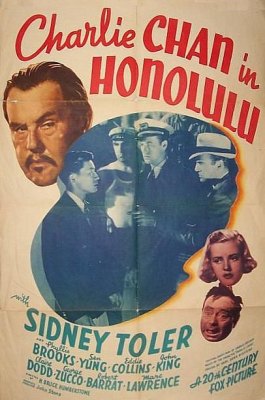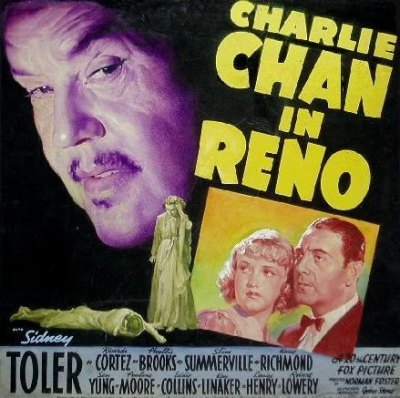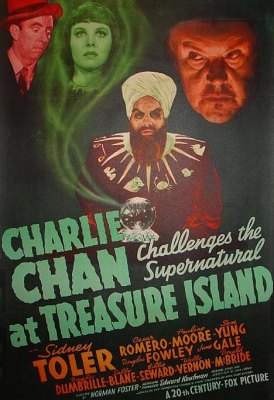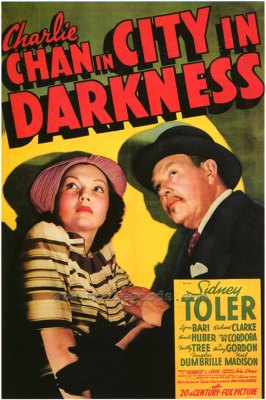| Reviews & Columns |
|
Reviews DVD TV on DVD Blu-ray 4K UHD International DVDs In Theaters Reviews by Studio Video Games Features Collector Series DVDs Easter Egg Database Interviews DVD Talk Radio Feature Articles Columns Anime Talk DVD Savant Horror DVDs The M.O.D. Squad Art House HD Talk Silent DVD
|
DVD Talk Forum |
|
|
| Resources |
|
DVD Price Search Customer Service #'s RCE Info Links |
|
Columns
|
|
|
Charlie Chan Volume 4 (Charlie Chan in Honolulu / Charlie Chan in Reno / Charlie Chan at Treasure Island / City in Darkness)
In any case, Charlie Chan was back on the case and this marvelous new DVD set offers the next four entries in the long-running series: Charlie Chan in Honolulu (1938), Charlie Chan in Rio, Charlie Chan at Treasure Island, and Charlie Chan in City in Darkness (all 1939). The films look great and each is accompanied by a feast of extra features. Though Oland and Luke are sorely missed, the films are still very entertaining on their own terms. MGM released a set of six Toler Chans back in 2004 as The Charlie Chan Chanthology, but these were made at Poverty Row studio Monogram after Fox lost interest in the character. Those films are desperately cheap and generally mediocre; the Toler-Fox Chans, on the other hand, retain all the slickness and polish of the Oland ones.
The big question for those new to the series is this: How does Toler (and, for that matter, Yung) measure up? While everyone seems to agree that Toler makes a perfectly serviceable Charlie Chan, the consensus is also that somehow he lacks Oland's warmth, though the reasons for this aren't easy to pinpoint. Oland's sad personal life aside, there seems to be a lot of Oland himself in his Charlie Chan, where Toler buries himself behind a mask-like portrayal. Oland's Chan outwardly appeared very stoic, with superficially inexpressive facial expressions, yet just below the surface was a man of great ironic wit and intelligence with enormous affection for his family, his deadpan criticisms of son Lee notwithstanding.
Toler seems to have been cast as much because of his resemblance to Oland as his acting skills. One of the commentators in one of the featurettes remarks about how much more Toler is made-up (in "Oriental" eye-makeup, etc.) as Chan compared to Oland, but the difference actually seems negligible to this reviewer. However, Toler is hiding behind the character (or, more generously, losing himself in the character) to such an extent that it's understandable to misinterpret it that way. (In the alarmingly bad Charlie Chan and the Curse of the Dragon Queen, an alleged comedy produced in 1981, star Peter Ustinov tellingly modeled his Chan after Toler rather than Oland, giving him the same stoicness and nasally voice.) Though by no means bad, Toler is like an imitation of Oland playing Charlie Chan, without even a fractional part of his own personality. Victor Sen Yung (She Demons, Bonanza) similarly lacks Keye Luke's breezy charm. Over time Yung became a better actor, but here he's not able to transcend the comic function of the part as Luke had done so well. Where Luke was energetic Yung is merely frantic, and where Oland's Chan was as much amused as annoyed by son Lee's unbridled, youthful enthusiasm for crime-solving, Jimmy more often than not is a source of irritation, closer to the books' annoying Kishimo, Charlie's hyperactive Japanese assistant.
"When money talk, few are deaf."
Charlie Chan in Honolulu (1938)
Clearly, Fox wanted to reassure audiences that even with a new actor in the title role, the revised series would be more of the same, hence the return to Charlie Chan's old stomping grounds and the reappearance of his BIG family (13 children in all), in opening scenes that offer the first good look at the Chan's ocean-side home. The title is something of a misnomer - except for that opening scene, virtually the entire film takes place in the cabins, passageways, and cargo hold of a freighter docked at Honolulu port. Audiences expecting hula girls and luaus were in for a disappointment. (Then again, who would have paid to see Charlie Chan aboard a Rusty Old Boat?)
Chan is called aboard the freighter Susan B. Jennings, just in from Shanghai, to investigate a murder but he's distracted by news from honorable son-in-law Wing Foo (Philip Ahn, whom I'd bet good money also tested for Jimmy) that Charlie's about to become a grandfather for the first time. When the entire Chan family rushes off to the maternity hospital - we're told Lee's gone off to art school in New York, a nod to Keye Luke's real-life day job as an artist - Jimmy and kid brother Willie Chan (Layne Tom, Jr.; other sources insist the name of the character is "Tommy") decide to solve the case themselves. After much confusion Charlie himself takes over.
The story concerns the murder of an unidentified man and the theft of $300,000 in cash stolen from courier Judy (Phyllis Brooks). Also aboard are handsome first mate George Randolph (John King), Judy's love interest; impatient Captain Johnson (Robert Barret, of Strangler of the Swamp); dopey animal keeper Hogan (Eddie Collins), who sleeps in the hold with Oscar, a lion; emphatically eccentric psychiatrist Dr. Cardigan (George Zucco), who all but wears a sign board with "Red Herring" in bold 12-inch type over his tweed jacket (he does not, however, wear a cardigan); divorcee Carol Wayne (Claire Dodd); and extradited gangster Johnny McCoy (Marc Lawrence), accompanied by private dick Joe Arnold (Richard Lane).
By confining most of the story to the freighter, possibly an existing set, Fox was hedging its bets with a cheap film that wouldn't lose too much money just in case audiences didn't take to Toler's Chan. The film reportedly cost around $300,000, but that might have included studio charges dating back to Oland's illness; I suspect the real cost was probably half that amount. Regardless, the confining nature of the story in some ways works to the picture's advantage, much like the Sherlock Holmes film Terror By Night (1946), which takes place almost entirely aboard a speeding train.
Classic horror film fans will enjoy George Zucco's wildly campy turn as a batty scientist. You'd think Zucco had been typecast in such roles for years yet this was practically (if not literally) his first wild-eyed Mad Scientist. Peering through requisite Coke bottle glasses he admires Jimmy Chan's glands: "Your pituitary...are very prominent," he says, staring at Jimmy's forehead. He's also fussy about the "living brain" of an executed Chinese murderer he keeps alive in a trunk, part of a larger collection at home, so he says. Though ludicrously overdone, Zucco's Dr. Cardigan is in keeping with the spirit of the series and its eccentric red herrings.
Less tolerable is Eddie Collins broad Vaudevillian mugging as animal keeper Hogan. Though Collins' rubbery face and saucer eyes impressively contort and twirl in every direction imaginable, he's given way too much screen time, nearly as much as Toler. Collins was put to better use in the Shirley Temple The Blue Bird and as the artists' model for Dopey in Snow White and the Seven Dwarfs.
"When searching for needle in haystack, haystack only sensible location."
Charlie Chan in Reno (1939)
Where the first of the new Toler Chans was helmed by H. Bruce Humberstone, the director of three of the best Oland Chans (including Charlie Chan at the Opera), Charlie Chan in Reno was supervised by actor-turned-director Norman Foster, who established his reputation behind the camera with Fox's slickly-made Mr. Moto movies. It's said that Foster brought the faster-pace and more authentic international flavor of the Motos to the Chan series. Most seem to agree that where Charlie Chan in Honolulu is something of an anomaly, a transitional film bordering the Oland and Toler years, between the 1930s Depression-era style filmmaking and '40s streamlined, war years slickness, Charlie Chan in Reno established the tone for the coming decade.
Maybe so, but Charlie Chan in Reno is less impressive overall, though it is definitely more consistent in tone. Charlie and Jimmy fly to Reno to help out an old family friend, Curtis Whitman (Kane Richmond), whose estranged wife Mary (Pauline Moore), in Reno seeking a divorce from Curtis, is accused of murdering Jeanne Bentley (Louise Henry) - whom coincidentally was planning on becoming the second Mrs. Whitman.
Clues eventually lead Chan to a spooky ghost town and abandoned mine, while suspects include shady Dr. Ainsley (Ricardo Cortez, filmdom's original Sam Spade), Jeanne's baby-faced lover Wally Burke (Robert Lowery, who'd age considerably over the next few years), and others.
Reno was, in early 1939, already infamous for its six-week divorce laws and casinos when Las Vegas was still little more than a dirt road with rolling tumbleweeds. Charlie Chan in Reno has some great footage of the "biggest little city in the world" but mostly as rear-projection plates and a few establishing shots - the cast never set foot outside of Los Angeles county for this one. Curiously, the art director's idea of Reno glamour is more than a little screwy; everything looks like what one might expect in Monaco, not Nevada. In any case the film is less interested in Reno for its gambling than for its salacious reputation ("This is 1939 - we're modern!" exclaims Mrs. Bentley, minutes before her murder) as a last-stop for unhappy celebrity and blueblood couples.
The broader comic elements are less pronounced than in Honolulu, though Eddie Collins is back in a smaller part described by the IMDb as "the Gabby Cabbie." Jimmy Chan borrows a college pal's car to get to Reno, but it's stolen by highway robbers in the desert and Jimmy is abandoned in his long johns. Amusingly, the screenwriters seem to have forgotten this little detail; when Jimmy finally turns up in Reno, he's totally oblivious to having screwed his friend over Big Time, and never even bothers to call his friend with the bad news. Conversely, one of the better ideas was to pair Jimmy with a love interest (Choy Wong), a Chinese maid; these cute comic-romantic subplots were always a highlight of the Keye Luke Chans, particularly in Charlie Chan at the Circus.
Charlie, meanwhile, gets a hick version of Inspector Lestrade in the form of Sheriff "Tombstone" Fletcher (Slim Summerville), a cynical Mr. Haney type. It's not really a good match, though it's fun to watch Chan outwit the dumb lawman at every turn. And it's hard to entirely dislike a film that touts Stanley Blystone, Fred Kelsey, and Heinie Conklin as Reno cops.
"Sometimes black magic very close to blackmail"
Charlie Chan at Treasure Island (1939)
Though its title suggests a South Seas pirate movie, this entertaining if totally preposterous and hopelessly Byzantine Chan has in its favor a great cast and mysterious mystics that inch the film into horror-fantasy. The Treasure Island of the title refers to the artificial island built in the San Francisco Bay and in 1939 was a major tourist attraction, the Golden Gate International Exposition, a West Coast alternative to the New York World's Fair.
Charlie and Jimmy Chan are investigating the death of family friend Paul Essex (Louis Jean Heydt), a writer who either committed suicide or was murdered while all were aboard the (unbelievably roomy) China Clipper bound for San Francisco. Clues lead Charlie to Dr. Zodiac, a hulking, vaguely Middle Eastern man said to have supernatural powers, but whom others, including reporter Pete Lewis (Douglas Fowley) and magician Fred Rhadini (Cesar Romero), believe to be a fraud. They suspect Dr. Zodiac is using his alleged powers as a front for a larger blackmailing scheme that has resulted in a string of tragic suicides.
Charlie Chan at Treasure Island is certainly one of the most entertaining of the Toler-era Chans, this despite a screenplay by John Larkin that literally makes no sense whatsoever. (Mild Spoilers) The biggest problem - one so fundamental you can almost hear sirens wailing in protest at the denouement - is that throughout the film the killer (whom I won't identify here) helpfully assists Charlie in his eventual discovery and capture!
I wouldn't be surprised if Larkin himself had no idea who the killer was going to be until page 70 of the script sat there naked in his typewriter. It seems like an arbitrary decision, perversely illogical from any number of angles. (Another problem is that the voice of Dr. Zodiac and the killer aren't the same, technically a cheat. The voice reportedly was provided by Gerald Mohr.) It's also odd that in a film in which some of the characters are out to expose fake mystics, Charlie Chan at Treasure Island itself clearly falls in the realm of fantasy in that at least one of the characters, Rhadini's mind-reading assistant, Eve Cairo (Pauline Moore again), is genuinely psychic! Which begs another question: If she really can wow audiences with her mind-reading act, why is she wasting her time as Rhadini's assistant? (Romero's pathetic sleight of hand tricks, the kind of thing a dedicated grade-schooler could pull off better, only emphasizes this further.)
Of course, none of this matters a bit. Logic was never high on the list of priorities with B-mysteries like Fox's Chan series, so to complain too loudly about it is beside the point. Better to let the film wash over you with its slick production values (belying a budget of probably well under $200,000) and fun cast. Indeed, Treasure Island has an unusually good one, as it also includes Donald McBride and Fred Kelsey (as cops, natch), Douglass Dumbrille as a sinister insurance actuary/investigator (his name misspelled once again on Fox's DVD back-cover art and in the onscreen credits), Charles Halton as Paul's business manager, and of course, Romero and Fowley, both in top form.
The spooky scenes in Dr. Zodiac's mansion are utterly tame by today's standards but probably frightened more innocent audiences back in 1939. Zodiac's psychic guidance chamber is loaded with all manner of contraptions: floating instruments, a disembodied head (another cheat, as it turns out) - in scenes that, for trivia buffs, were an obvious influence on Ed Wood's semi-Plan 9 from Outer Space sequel, Night of the Ghouls (1959).
"Wise man has said, 'Beware of spider who invite fly into parlor'"
Charlie Chan in City in Darkness (1939)
This awkwardly titled entry, amusingly given the series' only black backgrounded DVD cover art, is a drab and dreary entry more of historical interest than as entertainment. Victor Sen Yung's Jimmy Chan is absent, but that role is filled with annoying hamminess by Harold Huber (in his third of four Chan appearances) in the badly conceived role of Charlie's sidekick, Police Inspector Marcel Spivak, a man more exaggeratedly French than Pepe Le Pew.
The film is set in the recent past, Paris of September 28th and 29th specifically, as France nervously prepares for war against Germany during the Sudetenland Crisis and talks between Hitler, Neville Chamberlain, and Edouard Daladier in Munich. The title refers to plans to completely blackout Paris in anticipation of a possible enemy air raid.
Charlie Chan, ironically in town for a reunion of intelligence men from the last World War, is drawn into the investigation of the murder of a man called Petroff (Douglass Dumbrille), a wealthy exporter. Adapted from a Charlie Chan-less play by Ladislas Fodor and Gina Kaus, the film is rather rigidly compartmentalized: there are long scenes without Chan involving little groups of suspects who don't interact much, even during the last act when they're all brought together. For the record they include blackmailer and counterfeiter Louis Santelle (Leo G. Carroll, an unconvincing Frenchman indeed, given curly locks here) and his brutish, mute henchman (Lon Chaney, Jr., equally inauthentic); Tony Madero (Richard Clarke), who suspiciously is trying to flee the country with the aid of Petroff's wife, Marie (Lynn Bari); three bumbling burglars; and Antoine (Pedro de Cordoba, whose mother was French), Petroff's butler, a World War I veteran sending his son off to war that very evening.
City in Darkness is curiously, thoroughly uninvolving. About the only character that generates any interest at all is Dumbrille's sinister exporter, whose mocking of Antoine's and his son's patriotism is slickly menacing, Dumbrille's stock in trade. Bari is moderately sexy but the part is blah, and Clarke is like a hole in the screen.
Like Charlie Chan at the Olympics (1937), the main reason to watch City in Darkness is as a pop culture entertainment produced on the cusp of massive historical changes. The film went into production in July 1939, less than two months before Hitler's invasion of Poland on September 1st officially ignited the war in Europe. Charlie Chan in the City in Darkness opened two-and-a-half months later on November 15, 1939, about six months before France fell to the Nazis.
Like at the Olympics the picture is interesting in how it dances around real-world events, how it subtly criticizes the Nazis without being as openly propagandistic as Hollywood movies made in the wake of Pearl Harbor and official U.S. entry into the war. A documentary included about the film's production states that Chan's aphorism about the spider (an obvious reference to Hitler in case you missed it) was already in the final shooting script of July 1939 and not added, as one might reasonably have presumed, later in retakes shot in September or October.
Of course, its chief function is as a B-mystery designed to make money, but that too leads to some curious handling in the name of entertainment. The French come off alternately as fussy and foolish as much as brave and patriotic, something of a contrast to Hollywood movies about Britain made between September 1939 and December 1941, which generally depicted them as unilaterally heroic. Here the supporting French characters typically are loveable rogues or overexcited fops, exemplified by Huber's police inspector. In one scene he rushes around panic-stricken, madly gathering gas masks when an air raid seems imminent; this is regarded as highly comical by the filmmakers, a strange attitude to say the least.
Video & Audio
All four films look great. Unlike the major restoration work that went into the early Oland Chans, these Toler entries seem to have required much less work. In the restoration demonstrations included on each disc, most of the work appears to have involved eliminating the white speckling on their film masters. Generally, the full-frame images look great throughout. The mono audio (1.0 and 2.0 Dolby Digital), is adequate. Optional French and Spanish subtitles are included, along with optional English subtitles for the hard-of-hearing.
Extra Features
Reinventing Chan recaps Oland's last days and the search for his replacement. Intriguingly, among the actors considered were such bizarre choices as Leo Carrillo, Noah Beery (Sr.), and J. Edward Bromberg. Not mentioned in the documentary but noted on a Variety headline shown during the piece is that "Coburn" is among those doing screen tests. Presumably this would have been Charles Coburn, who might have been a great (though surely slyer and rascally) Chan. Sidney Toler: The Man Who Became Chan offers a nice career overview. Also included with Charlie Chan in Honolulu is a still and audio reconstruction of Charlie Chan's Courage, a lost 1934 Warner Oland film that still managed to get 143 votes on the IMDb!
Charlie Chan in Reno's extras include a trailer and three featurettes: Welcome to Reno: America's Divorce Resort, Reno Memories, and Chan's Killer Actress: Kay Linaker, the now-94-year-old retired actress who did four Chans and later co-wrote The Blob!
The Real Treasure Island is a highlight, offering a sweetly fascinating glimpse with personal recollections of that World's Fair-type event. Conversely, Charlie Chan and the Zodiac seems to come out of left field, drawing parallels between the 1939 film and the Zodiac Killer of the late-1960s, suggesting Charlie Chan at Treasure Island might have influenced the still-at-large serial killer. Ken Hanke and John Cork provide an audio commentary for the feature presentation.
The Making of Charlie Chan in City in Darkness puts everything in historical perspective (with the aid of Scott McIsaac and Rick Jewell, among others). Special features producer Cork is also on hand though he overstates the film's supposed daringness. Writing Chan: Robert Ellis and Helen Logan profiles the surprisingly varied life of the studio screenwriting team and their careers at Fox.
Restoration Demonstrations and Still Galleries are included with each film.
Parting Thoughts
Though neither Sidney Toler nor the four films in this set are up to Warner Oland's best, Charlie Chan Volume 4 is still a delight with solidly entertaining B-mysteries and some great supplementary features that make this a highly desirable package. Highly Recommended.
Note: This reviewer is indebted to the wonderful website The Charlie Chan Family Home, a great resource.
  Film historian Stuart Galbraith IV's latest books, Japanese Cinema and The Toho Studios Story, are now available for pre-order.
|
| Popular Reviews |
| Sponsored Links |
|
|
| Sponsored Links |
|
|
| Release List | Reviews | Shop | Newsletter | Forum | DVD Giveaways | Blu-Ray | Advertise |
|
Copyright 2024 DVDTalk.com All Rights Reserved. Legal Info, Privacy Policy, Terms of Use,
Manage Preferences,
Your Privacy Choices | |||||||

















